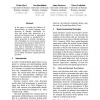Free Online Productivity Tools
i2Speak
i2Symbol
i2OCR
iTex2Img
iWeb2Print
iWeb2Shot
i2Type
iPdf2Split
iPdf2Merge
i2Bopomofo
i2Arabic
i2Style
i2Image
i2PDF
iLatex2Rtf
Sci2ools
SIGDIAL
2010
2010
The Impact of Dimensionality on Natural Language Route Directions in Unconstrained Dialogue
In this paper we examine the influence of dimensionality on natural language route directions in dialogue. Specifically, we show that giving route instructions in a quasi-3d environment leads to experiential descriptive accounts, as manifested by a higher proportion of location descriptions, lack of chunking, use of 1st person singular personal pronouns, and more frequent use of temporal and spatial deictic terms. 2d scenarios lead to informative instructions, as manifested by a frequent use of motion expressions, chunking of route elements, and use of mainly 2nd person singular personal pronouns.
Natural Language Processing | Natural Language Route | SIGDIAL 2010 | Singular Personal Pronouns | Spatial Deictic Terms |
| Added | 15 Feb 2011 |
| Updated | 15 Feb 2011 |
| Type | Journal |
| Year | 2010 |
| Where | SIGDIAL |
| Authors | Vivien Mast, Jan Smeddinck, Anna Strotseva, Thora Tenbrink |
Comments (0)

